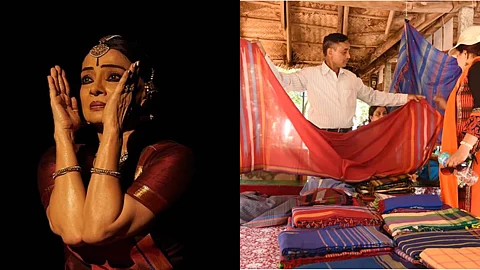
- HOMEGROWN WORLD
- #HGCREATORS
- #HGEXPLORE
- #HGVOICES
- #HGSHOP
- CAREERS
- ABOUT US
- CONTACT US

What sets DakshinaChitra apart is its ability to bring history to life. Set in the south of Chennai and founded by Madras Craft Foundation, this cross-cultural museum has been displaying the many lifestyles and cultures of South Indians since 1996.
The mention of DakshinaChitra, a cross-cultural, living-history heritage museum, instantly ignites curiosity. What does it truly mean to embark on a journey through time and witness the rich heritage of Southern India come alive?
DakshinaChitra offers visitors a unique opportunity to step into recreated streetscapes, where the past seamlessly merges with the present. As one explores these immersive settings, engages with skilled artisans, and immerses themselves in folk performances, DakshinaChitra serves as testament to the living history of Southern India.
The museum showcases the vibrant customs and styles of living of various South Indian communities, representing regions such as Kerala, Tamil Nadu, Andhra Pradesh, and Karnataka. Beyond mere exhibits, DakshinaChitra hosts permanent exhibitions, craft bazaars, shops, textile workshops, and regular folk performances, offering visitors a comprehensive understanding of the rich cultural heritage of the region.
For those with a keen interest in anthropology and a desire to delve deeper into the history of South India, DakshinaChitra becomes an irresistible destination. Stepping through its doors transports visitors into a world where the past harmoniously intertwines with the present, providing a lens to study the customs, traditions, and architectural styles of the region.
DakshinaChitra's dedication to preserving these historical houses goes beyond mere restoration. The museum recognizes the importance of safeguarding intangible heritage associated with these homes as well. Efforts are made to document and archive the stories, rituals, and traditions connected to these houses, ensuring that future generations can learn from and appreciate the cultural richness embedded within them.
It is worth noting that while the museum celebrates the culture and heritage of South India, the main stakeholders and architects behind the project are individuals of non-South Indian descent. Dr Deborah Thiagarajan, inspired by the region's rich heritage, founded the Madras Craft Foundation in 1984, and architect Laurie Baker played a pivotal role in its spatial conceptualization. Architect Benny Kuriakose also contributed by designing public buildings and overseeing the conservation and reconstruction of heritage structures.
While showcasing the rich cultural tapestry of the region, the museum also sparks discussions and debates regarding the construction of heritage narratives and the commodification of culture. Cynics have noticed its romanticised portrayal of rural and village life and its perceived ties to consumerism and elite perceptions of regional and national heritage. DakshinaChitra accompanies each historical house with information, pictures, and artifacts that provide insights into the house's history, the lives of its inhabitants, and the region it represents. While this contextual information enriches the visitor experience, skeptics argue that it may perpetuate stereotypes or add to the romanticised narrative.
Mary Hancock, in a paper, suggests that the museum's vision deviates from and challenges the cultural and historical narratives inscribed by the state in urban public spaces. These criticisms raise important questions about the representation and commodification of cultural heritage within the museum.
But no matter where one stands in the discourse surrounding the museum, there is undeniable value in experiencing the cultural heritage firsthand. DakshinaChitra, which means "a picture of the South," offers visitors an immersive journey into South India's traditions and customs. By visiting DakshinaChitra, one can witness the living heritage that shapes the region. So, whether you are an enthusiast, academic or simply curious about the rich cultural legacy of South India, DakshinaChitra beckons you to embark on a personal exploration and discover the 'picture of the South’ for yourself.
If you enjoyed reading this, here's more from Homegrown:
